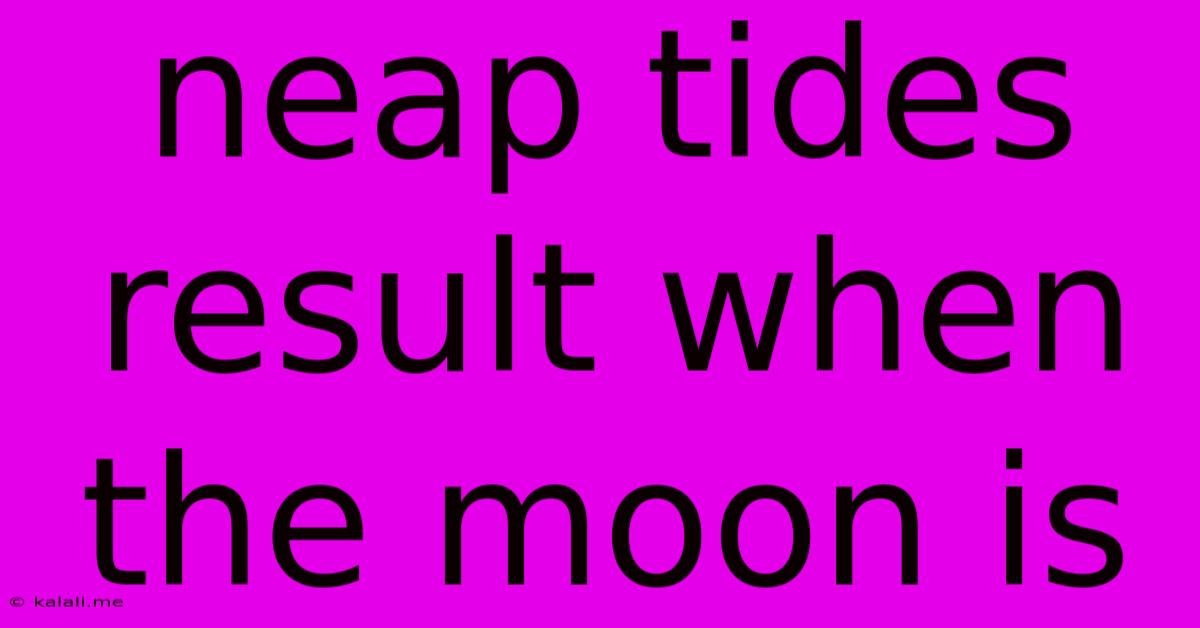Neap Tides Result When The Moon Is
Kalali
Jun 14, 2025 · 3 min read

Table of Contents
Neap Tides: When the Moon is at Right Angles to the Sun
Neap tides, characterized by their smaller tidal range compared to spring tides, occur when the sun, Earth, and moon are at right angles to each other. This configuration significantly reduces the gravitational forces that combine to create the dramatic high and low tides we see during spring tides. Understanding the celestial mechanics behind neap tides is key to predicting coastal water levels and planning activities accordingly.
What Causes Neap Tides?
The gravitational pull of both the sun and the moon influences Earth's tides. While the moon's proximity makes its gravitational effect significantly stronger, the sun also plays a considerable role. During neap tides, the sun and moon are positioned at approximately 90-degree angles in relation to the Earth. This means their gravitational forces partially cancel each other out. Instead of working together to amplify the tidal bulge, they create a weaker combined force, resulting in smaller differences between high and low tides.
The Moon's Phases and Neap Tides
The moon's phases directly correlate with the type of tides experienced. Neap tides happen during the first and third quarter moons. At these points in the lunar cycle, the sun and moon exert their gravitational pulls at nearly right angles to each other.
- First Quarter Moon: The moon is positioned approximately 90 degrees ahead of the Earth in its orbit around the sun.
- Third Quarter Moon: The moon is positioned approximately 90 degrees behind the Earth in its orbit around the sun.
During these phases, the combined gravitational pull is less pronounced, resulting in the smaller tidal range observed during neap tides.
Differences Between Neap and Spring Tides
It's important to distinguish neap tides from their counterparts, spring tides. While neap tides showcase smaller tidal ranges, spring tides exhibit significantly larger differences between high and low tides. This contrasting behavior stems from the alignment of the sun, Earth, and moon:
- Neap Tides: Sun, Earth, and moon form a right angle (90 degrees). Gravitational forces partially cancel each other out, leading to smaller tidal ranges.
- Spring Tides: Sun, Earth, and moon are aligned (0 or 180 degrees). Gravitational forces combine, creating larger tidal ranges.
Predicting Neap Tides
Predicting neap tides involves understanding the moon's phases and its position relative to the sun and Earth. Tidal prediction charts and software are readily available and utilize complex algorithms incorporating these celestial positions and other factors like coastline geometry and water depth.
Impact of Neap Tides on Coastal Activities
The reduced tidal range during neap tides affects various coastal activities. For example:
- Boating: Navigating shallow waters might be easier due to the higher water levels at low tide.
- Fishing: Changes in water flow and depth can influence fish behavior and fishing spots.
- Beachcombing: The smaller tidal range might mean less beach exposed for exploring.
In conclusion, neap tides, resulting from the moon's position at right angles to the sun, offer a distinct contrast to spring tides. Understanding the interplay of gravitational forces from the sun and the moon is crucial in predicting and understanding these tidal variations, allowing for better planning of coastal activities and overall appreciation of the celestial mechanics that shape our oceans.
Latest Posts
Latest Posts
-
The Meaning Of Words And Sentences Is Called
Jun 15, 2025
-
Device That Converts Mechanical Energy Into Electrical Energy
Jun 15, 2025
-
What Is The Lcm Of 36 And 45
Jun 15, 2025
-
Compound Interest Formula Excel Between Two Dates
Jun 15, 2025
-
Difference Between Winter And Summer Olympics
Jun 15, 2025
Related Post
Thank you for visiting our website which covers about Neap Tides Result When The Moon Is . We hope the information provided has been useful to you. Feel free to contact us if you have any questions or need further assistance. See you next time and don't miss to bookmark.